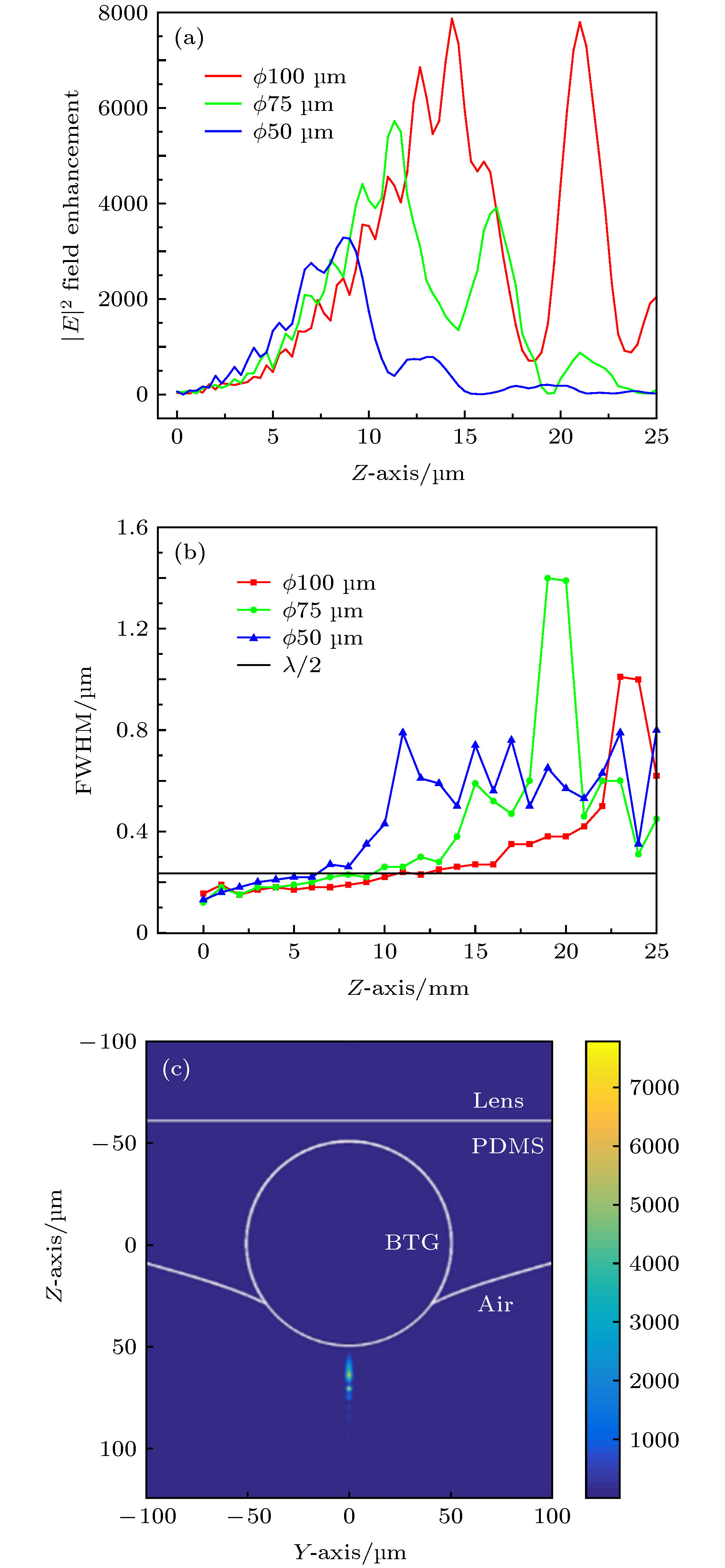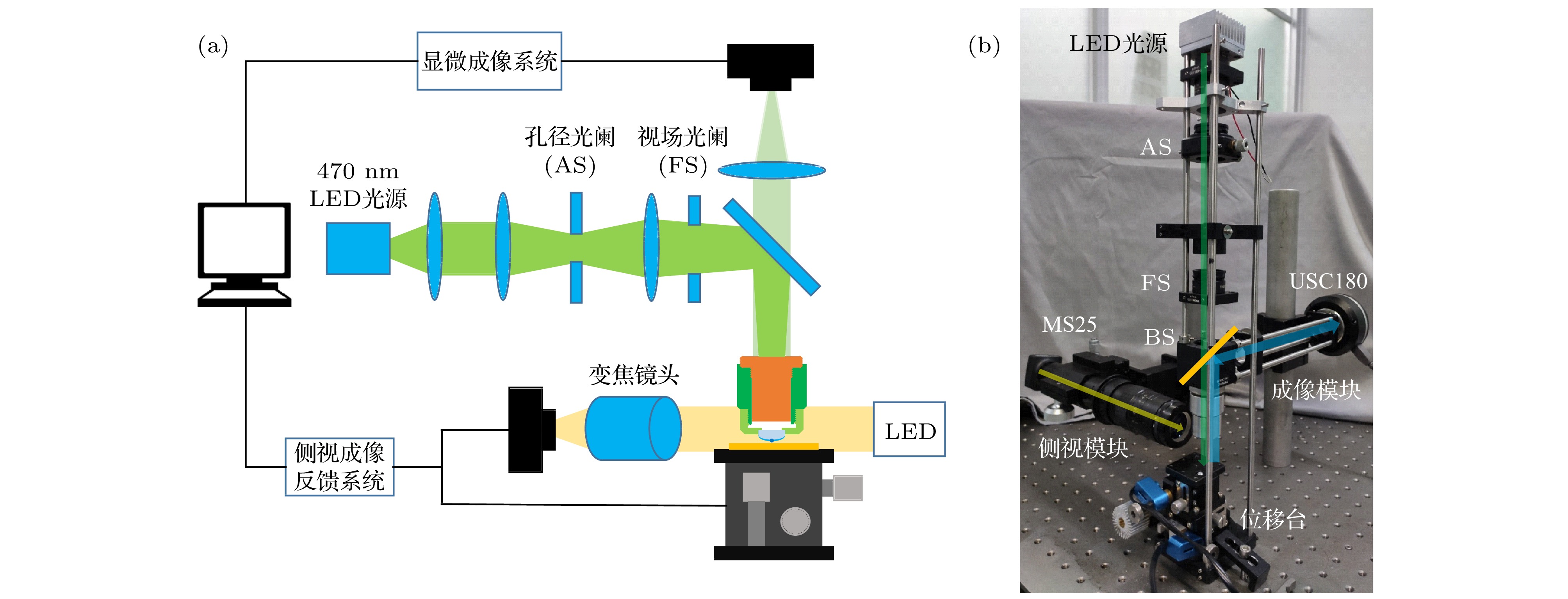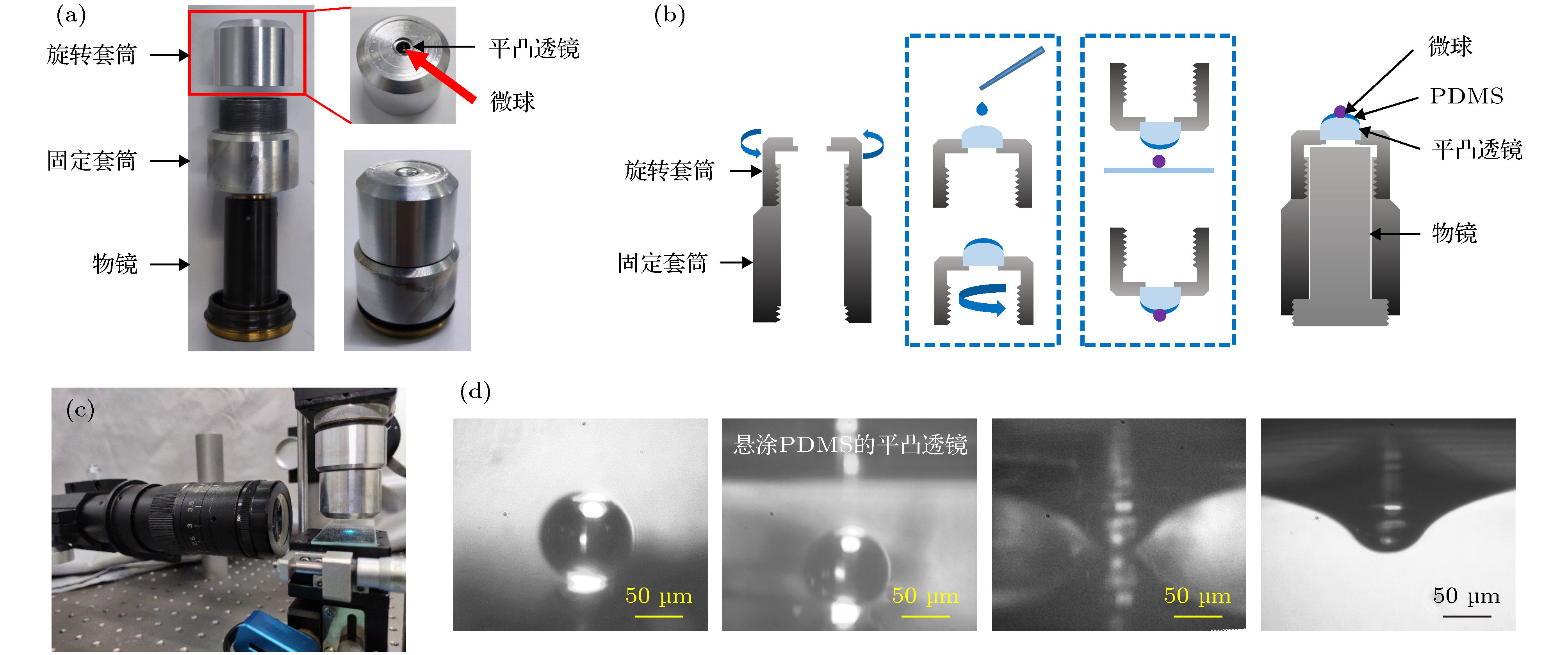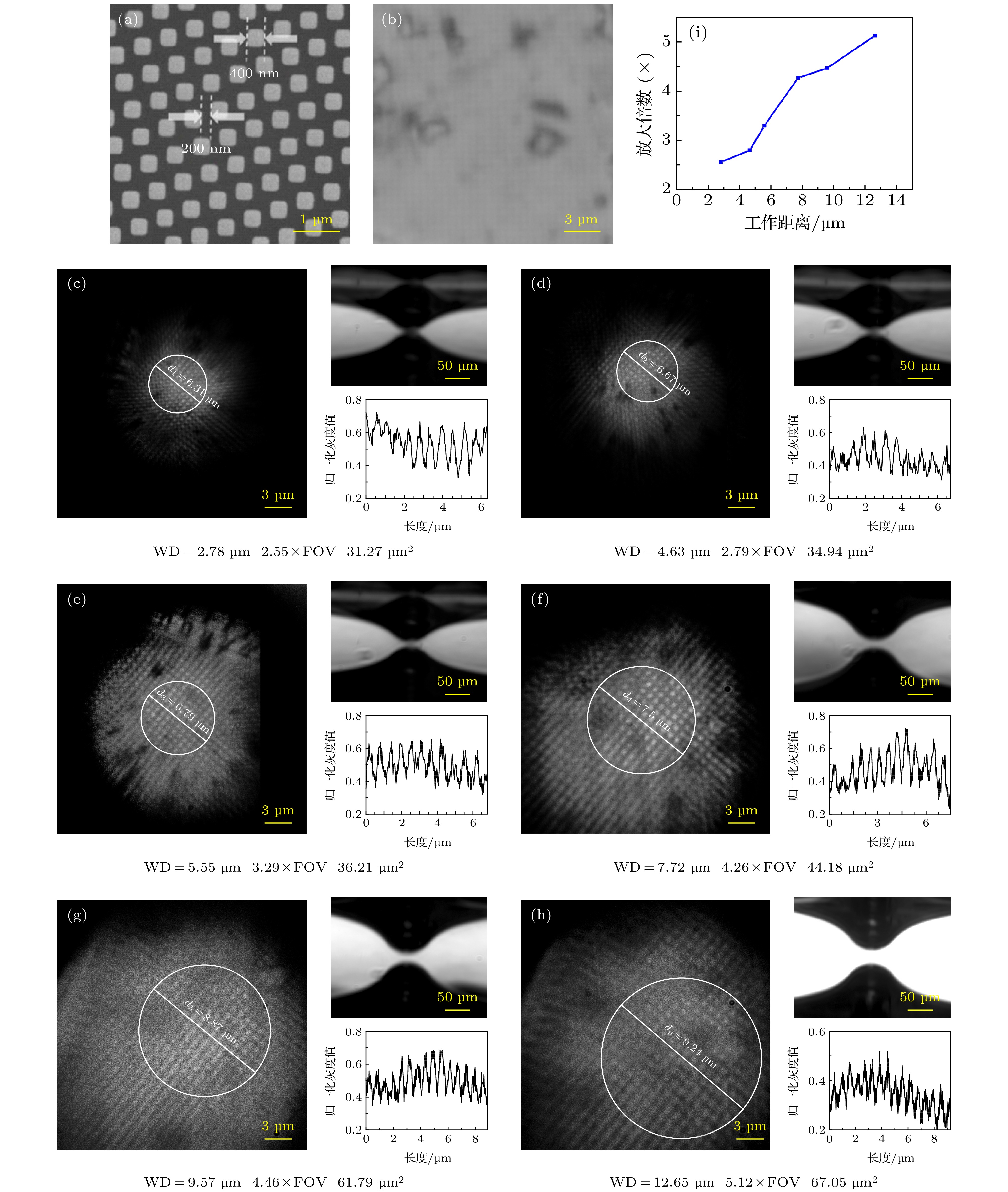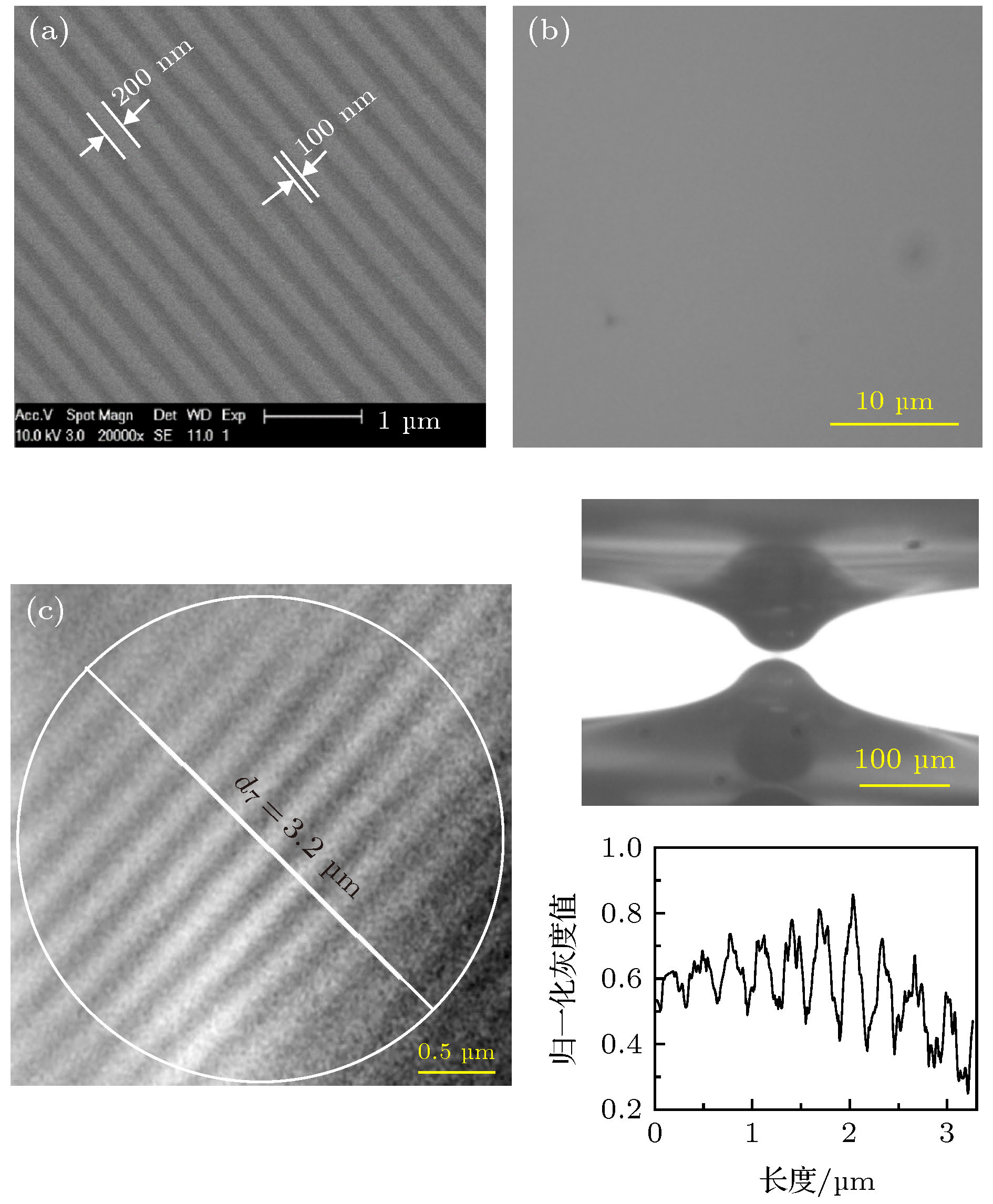-
利用直径微米量级的透明微球与传统光学显微镜相结合, 可以在白光下实现超分辨成像. 目前大部分研究是将微球直接播撒到样品表面, 由于微球位置的随机性和不连续性导致无法实现特定区域的完整成像, 极大限制了该技术的使用范围. 使用微探针或微悬臂黏附微球, 通过三维位移台精确控制微球位置, 一定程度上解决了上述问题, 但是需要对微球位置进行精准操控. 本文提出了一种结构稳定、参数可控、简单易用的基于一体化微球物镜的超分辨成像系统, 对微球与物镜进行了一体化安装设计, 通过设计侧视成像及位置反馈系统实现了对微球、物镜和样品三者之间距离的精准控制, 结合通用的显微成像系统, 实现了对可控特定区域的超分辨成像. 该系统将普通显微物镜(40×, NA 0.6)的分辨能力提高了4.78倍, 最高可以看到100 nm的样品特征. 该一体化物镜可以搭配普通光学显微系统使用, 实现超分辨成像, 提高了微球超分辨技术的通用性, 在亚衍射极限样品的超分辨成像方面具有广泛的应用价值.White-light super-resolution imaging, proposed in 2011, has been achieved by combining the transparent microspheres of the micron scale with an ordinary optical microscope. At present, in most of the researches employed is the way of spreading microspheres directly onto the surface of sample, which causes the randomness and discontinuity of microspheres. It is impossible to achieve the complete imaging of specific regions, which greatly limits the application scope of this technology. Such an issue can be solved by using microprobes or micro-cantilevers to precisely transfer the location of microsphere, but for doing so, a sophisticated controlling system is required, which is costly and not user-friendly. In this paper, a robust, controllable, easy-to-use integrated design which can efficiently consolidate microsphere and objective together is demonstrated for super-resolution imaging. The PDMS and customized metal sleeve are used to encapsulate the microsphere semi-submerged on the ordinary objective lens to achieve an integrated design. In this system, the distances among the microsphere, objective lens and the sample are controlled accurately by building a side-view imaging and position feedback system. With the help of a universal microscopic imaging system, the super-resolution imaging of specific controlled areas is realized. Based on theoretical analysis, the semi-submerged structure of the 100-μm-diameter BaTiO3 microsphere has a strong focusing effect, which can form the so-called ‘photonic nanojet’ on a micro-scale in length and on a sub-diffraction scale in waist to possess the ability to break through the diffraction limit within the range of focal length. At the same time, experiments are carried out for investigating imaging performances at various working distances in the air. According to the experimental results, the system can clearly distinguish between the CPU lattice features of 200 nm and the Blu-ray disc fringe of 100 nm, which means that the resolution of the ordinary microscopic objective lens (40×, NA 0.6) is significantly enhanced by 4.78×. In addition, with the increase of working distance, the magnification factor increases gradually, but the image contrast becomes worse, and the super-resolution effect fades. The integrated design which can match with ordinary optical microscope to achieve super resolution imaging has universality of installation and operation, and greatly conduces to super-resolution imaging of sub-diffraction limit samples.
-
Keywords:
- microsphere super-resolution imaging /
- integrated objective /
- side-view imaging feedback system
[1] Rust M J, Bates M, Zhuang X W 2006 Nat. Methods 3 793
 Google Scholar
Google Scholar
[2] Betzig E, Patterson G H, Sougrat R, Lindwasser O W, Olenyeh S, Bonifadno J S Davidson M W, Lippincott-Schwartz J, Hess H F 2006 Science 313 1642
 Google Scholar
Google Scholar
[3] Hess S T, Girirajan T P K, Mason M D 2006 Biophys. J. 91 4258
 Google Scholar
Google Scholar
[4] Klar T A, Jakobs S, Dyba M, Egner A, Hell S W 2000 Proc. Natl. Acad. Sci. U.S.A. 97 8206
 Google Scholar
Google Scholar
[5] Gustafsson M G L 2000 J. Microsc. Oxford 198 82
 Google Scholar
Google Scholar
[6] Gustafsson M G L, Webb W W 2005 Proc. Natl. Acad. Sci. U.S.A. 102 13081
 Google Scholar
Google Scholar
[7] Wang Z B, Guo W, Li L, Luk’yanchuk B, Khan A, Liu Z, Chen Z C, Hong M H 2011 Nat. Commun. 2 218
 Google Scholar
Google Scholar
[8] Wang Z B, Li L 2011 Laser Focus World 7 61
[9] O'Brien P, Thomas P J 2016 Nanoscience (Vol. 3) (London: Royal Society of Chemistry) p193
[10] Li L, Guo W, Yan Y Z, Lee S, Wang T 2013 Light Sci. Appl. 2 e104
 Google Scholar
Google Scholar
[11] Hao X, Kuang C F, Liu X, Zhang H J, Li Y H 2011 Appl. Phys. Lett. 99 203102
 Google Scholar
Google Scholar
[12] Hao X, Kuang C F, Li Y H, Liu X, Ku Y L, Jiang Y S 2012 Opt. Commun. 285 4130
 Google Scholar
Google Scholar
[13] Darafsheh A, Walsh G F, Negro L D, Astratov V N 2012 Appl. Phys. Lett. 101 141128
 Google Scholar
Google Scholar
[14] Darafsheh A, Limberopoulos N I, Derov J S, Walker Jr D E, Durska M, Krizhanovskii D N, Whittaker D M, Astratov V N 2013 Nanoscale Imaging, Sensing, and Actuation for Biomedical Applications X San Francisco, United States of America, February 6−7, 2013 p85940C
[15] Darafsheh A, Limberopoulos N I, Derov J S, Walker Jr D E, Astratov V N 2014 Appl. Phys. Lett. 104 061117
 Google Scholar
Google Scholar
[16] Darafsheh A, Guardiola C, Nihalani D, Lee D, Finlay J C, Cárabe A 2015 Nanoscale Imaging, Sensing, and Actuation for Biomedical Applications XII San Francisco, United States of America, February 7−12, 2015 p933705
[17] Darafsheh A, Guardiola C, Palovcak A, Finlay J C, Cárabe A 2015 Opt. Lett. 40 5
 Google Scholar
Google Scholar
[18] Krivitsky L A, Wang J J, Wang Z B, Luk’yanchuk B 2013 Sci. Rep. 3 3501
 Google Scholar
Google Scholar
[19] 王淑莹, 章海军, 张冬仙 2013 物理学报 62 034207
 Google Scholar
Google Scholar
Wang S Y, Zhang H J, Zhang D X 2013 Acta Phys. Sin. 62 034207
 Google Scholar
Google Scholar
[20] Wang S Y, Zhang D X, Zhang H J, Han X, Xu R 2015 Microsc. Res. Tech. 78 1128
 Google Scholar
Google Scholar
[21] 王淑莹 2017 博士学位论文 (杭州: 浙江大学)
Wang S Y 2017 Ph. D. Dissertation (Hangzhou: Zhejiang University) (in Chinese)
[22] Wang F F, Liu L Q, Yu H B, Wen Y D, Yu P, Liu Z, Wang Y C, Li W J 2016 Nat. Commun. 7 13748
 Google Scholar
Google Scholar
[23] 陈涛, 孟凯, 杨湛, 刘会聪, 孙立宁 2018 光学精密工程 26 1106
 Google Scholar
Google Scholar
Chen T, Meng K, Yang Z, Liu H C, Sun L N 2018 Opt. Precis. Eng. 26 1106
 Google Scholar
Google Scholar
[24] Yan B, Wang Z B, Parker A L, Lai Y K, Thomas P J, Yue L, Monks J N 2017 Appl. Opt. 56 3142
 Google Scholar
Google Scholar
[25] Chen L W, Zhou Y, Wu M X, Hong M H 2018 OEA 1 17000101
[26] Phaos Technology Beyond Optical Limit, Hong M H http://phaos.com.sg/index.php/our-innovation/ [2020-4-3]
[27] Lee S, Li L, Wang Z B, Guo W, Yan Y Z, Wang T 2013 Appl. Opt. 52 7265
 Google Scholar
Google Scholar
[28] Lee S, Li L, Wang Z B 2014 J. Opt.-U.K. 16 015704
 Google Scholar
Google Scholar
[29] 王建国, 杨松林, 叶永红 2018 物理学报 67 214209
 Google Scholar
Google Scholar
Wang J G, Yang S L, Ye Y H 2018 Acta Phys. Sin. 67 214209
 Google Scholar
Google Scholar
-
图 2 (a)直径50, 75 和100 μm的BTG微球形成的光子纳米射流沿Z轴方向的光强变化曲线; (b)三种直径微球形成的光子纳米射流的半高宽变化状态; (c)在波长470 nm的光源下, 直径100 μm微球形成的光子纳米射流状态
Fig. 2. (a) Intensity curve value in Z-axis direction of the photonic nanojet formed by BTG microspheres with diameters of 50, 75 and 100 μm; (b) FWHM of the photonic nanojet formed by BTG microspheres; (c) The photonic nanojet formed by 100 μm microspheres at the wavelength of 470 nm.
图 4 (a)超分辨微球物镜实物图; (b)超分辨微球物镜的制作过程, 主要包括1)套筒的制作, 2)PDMS的涂覆, 3)微球的黏附, 4)一体化物镜; (c)侧视成像反馈系统实物图; (d)微球的黏附过程, 主要包括1)微球的定位, 2)透镜的下压, 3)微球的黏附, 4)位移台的下移
Fig. 4. (a) Physical image of the super-resolution microsphere objective; (b) Fabrication of the super-resolution microsphere objective lens. It mainly includes 1) sleeves, 2) coating of PDMS, 3) adhesion of microspheres, 4) integrated objective lens; (c) Physical image of side-view imaging and position feedback system; (d) Adhesion of microspheres. It mainly includes 1) positioning of microspheres, 2) downward of the lens, 3) adhesion of microspheres, 4) downward of the displacement table.
图 6 (a)扫描电子显微镜(SEM)观测到的CPU点阵结构; (b)不使用微球时的观察效果; (c)−(h)使用直径100 μm微球分别在工作距离2.78, 4.63, 5.55, 7.72, 9.57和12.65 μm处观察到的点阵效果, 每组图的左侧为显微图像, 其中白色圆圈内是视场范围, 直径(白色线段)处的灰度值变化曲线如右下角所示, 右上角是相应的侧视图. 它们都可以有效分辨出200 nm的点阵特征; (i)微球放大倍数与工作距离的关系曲线
Fig. 6. (a) The CPU lattice structure, 400 nm blocks and 200 nm intervals, observed by scanning electron microscope (SEM); (b) the observation without microsphere lens; (c)−(h) the lattice observed at the working distance of 2.78, 4.63, 5.55, 7.72, 9.57 and 12.65 μm, respectively, with 100 μm diameter microspheres. The left side of each group of images is the microscopic image, in which the field of view is inside the white circle, the gray value change curve at the diameter (the white line) is shown in the lower right corner, and the upper right corner is the corresponding side-view images. All of them can effectively distinguish 200 nm lattice features; (i) the relationship curve between the magnification factor and the working distance of the microsphere.
图 7 (a)扫描电子显微镜(SEM)观测到的蓝光光盘条纹; (b)不使用微球时的观察效果; (c)使用微球时的观察效果. 左侧为显微图像, 可以清晰地观察到蓝光光盘条纹, 其中白色圆圈内是视场范围, 直径(白色线段)处的灰度值变化曲线如右下角所示, 右上角是相应的侧视图. 此时的工作距离约为3 μm, 视场范围约8.04 μm2
Fig. 7. (a) The BD-ROM fringe observed by scanning electron microscope (SEM); (b) the observation without microsphere lens; (c) the observation with microsphere lens. The left side of image is the microscopic image, the BD-ROM fringe can be observed clearly, in which the field of view is inside the white circle, the gray value change curve at the diameter (the white line) is shown in the lower right corner, and the upper right corner is the corresponding side-view images. The working distance is about 3 μm and the field of view is about 8.04 μm2.
-
[1] Rust M J, Bates M, Zhuang X W 2006 Nat. Methods 3 793
 Google Scholar
Google Scholar
[2] Betzig E, Patterson G H, Sougrat R, Lindwasser O W, Olenyeh S, Bonifadno J S Davidson M W, Lippincott-Schwartz J, Hess H F 2006 Science 313 1642
 Google Scholar
Google Scholar
[3] Hess S T, Girirajan T P K, Mason M D 2006 Biophys. J. 91 4258
 Google Scholar
Google Scholar
[4] Klar T A, Jakobs S, Dyba M, Egner A, Hell S W 2000 Proc. Natl. Acad. Sci. U.S.A. 97 8206
 Google Scholar
Google Scholar
[5] Gustafsson M G L 2000 J. Microsc. Oxford 198 82
 Google Scholar
Google Scholar
[6] Gustafsson M G L, Webb W W 2005 Proc. Natl. Acad. Sci. U.S.A. 102 13081
 Google Scholar
Google Scholar
[7] Wang Z B, Guo W, Li L, Luk’yanchuk B, Khan A, Liu Z, Chen Z C, Hong M H 2011 Nat. Commun. 2 218
 Google Scholar
Google Scholar
[8] Wang Z B, Li L 2011 Laser Focus World 7 61
[9] O'Brien P, Thomas P J 2016 Nanoscience (Vol. 3) (London: Royal Society of Chemistry) p193
[10] Li L, Guo W, Yan Y Z, Lee S, Wang T 2013 Light Sci. Appl. 2 e104
 Google Scholar
Google Scholar
[11] Hao X, Kuang C F, Liu X, Zhang H J, Li Y H 2011 Appl. Phys. Lett. 99 203102
 Google Scholar
Google Scholar
[12] Hao X, Kuang C F, Li Y H, Liu X, Ku Y L, Jiang Y S 2012 Opt. Commun. 285 4130
 Google Scholar
Google Scholar
[13] Darafsheh A, Walsh G F, Negro L D, Astratov V N 2012 Appl. Phys. Lett. 101 141128
 Google Scholar
Google Scholar
[14] Darafsheh A, Limberopoulos N I, Derov J S, Walker Jr D E, Durska M, Krizhanovskii D N, Whittaker D M, Astratov V N 2013 Nanoscale Imaging, Sensing, and Actuation for Biomedical Applications X San Francisco, United States of America, February 6−7, 2013 p85940C
[15] Darafsheh A, Limberopoulos N I, Derov J S, Walker Jr D E, Astratov V N 2014 Appl. Phys. Lett. 104 061117
 Google Scholar
Google Scholar
[16] Darafsheh A, Guardiola C, Nihalani D, Lee D, Finlay J C, Cárabe A 2015 Nanoscale Imaging, Sensing, and Actuation for Biomedical Applications XII San Francisco, United States of America, February 7−12, 2015 p933705
[17] Darafsheh A, Guardiola C, Palovcak A, Finlay J C, Cárabe A 2015 Opt. Lett. 40 5
 Google Scholar
Google Scholar
[18] Krivitsky L A, Wang J J, Wang Z B, Luk’yanchuk B 2013 Sci. Rep. 3 3501
 Google Scholar
Google Scholar
[19] 王淑莹, 章海军, 张冬仙 2013 物理学报 62 034207
 Google Scholar
Google Scholar
Wang S Y, Zhang H J, Zhang D X 2013 Acta Phys. Sin. 62 034207
 Google Scholar
Google Scholar
[20] Wang S Y, Zhang D X, Zhang H J, Han X, Xu R 2015 Microsc. Res. Tech. 78 1128
 Google Scholar
Google Scholar
[21] 王淑莹 2017 博士学位论文 (杭州: 浙江大学)
Wang S Y 2017 Ph. D. Dissertation (Hangzhou: Zhejiang University) (in Chinese)
[22] Wang F F, Liu L Q, Yu H B, Wen Y D, Yu P, Liu Z, Wang Y C, Li W J 2016 Nat. Commun. 7 13748
 Google Scholar
Google Scholar
[23] 陈涛, 孟凯, 杨湛, 刘会聪, 孙立宁 2018 光学精密工程 26 1106
 Google Scholar
Google Scholar
Chen T, Meng K, Yang Z, Liu H C, Sun L N 2018 Opt. Precis. Eng. 26 1106
 Google Scholar
Google Scholar
[24] Yan B, Wang Z B, Parker A L, Lai Y K, Thomas P J, Yue L, Monks J N 2017 Appl. Opt. 56 3142
 Google Scholar
Google Scholar
[25] Chen L W, Zhou Y, Wu M X, Hong M H 2018 OEA 1 17000101
[26] Phaos Technology Beyond Optical Limit, Hong M H http://phaos.com.sg/index.php/our-innovation/ [2020-4-3]
[27] Lee S, Li L, Wang Z B, Guo W, Yan Y Z, Wang T 2013 Appl. Opt. 52 7265
 Google Scholar
Google Scholar
[28] Lee S, Li L, Wang Z B 2014 J. Opt.-U.K. 16 015704
 Google Scholar
Google Scholar
[29] 王建国, 杨松林, 叶永红 2018 物理学报 67 214209
 Google Scholar
Google Scholar
Wang J G, Yang S L, Ye Y H 2018 Acta Phys. Sin. 67 214209
 Google Scholar
Google Scholar
计量
- 文章访问数: 11526
- PDF下载量: 234
- 被引次数: 0













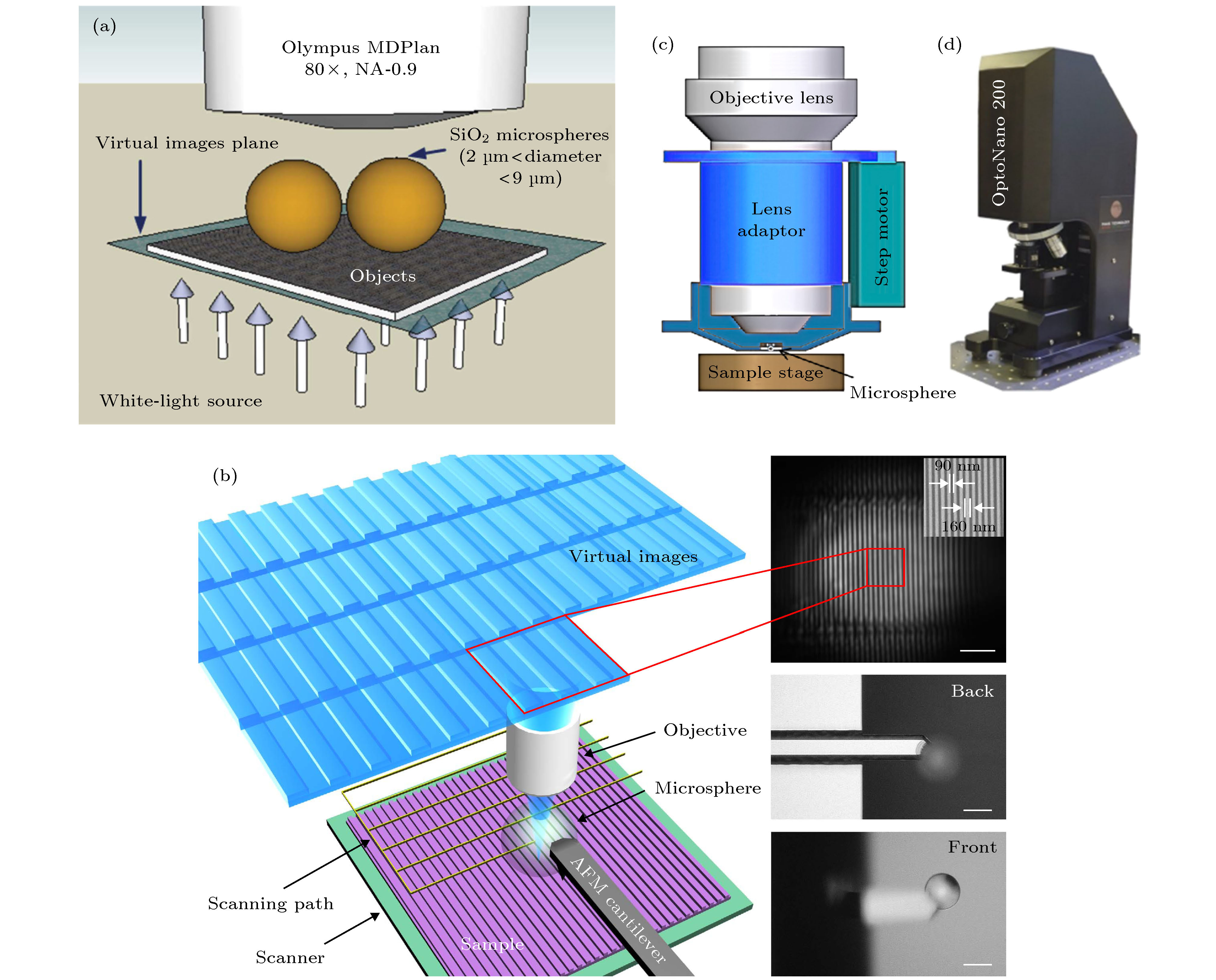
 下载:
下载:
